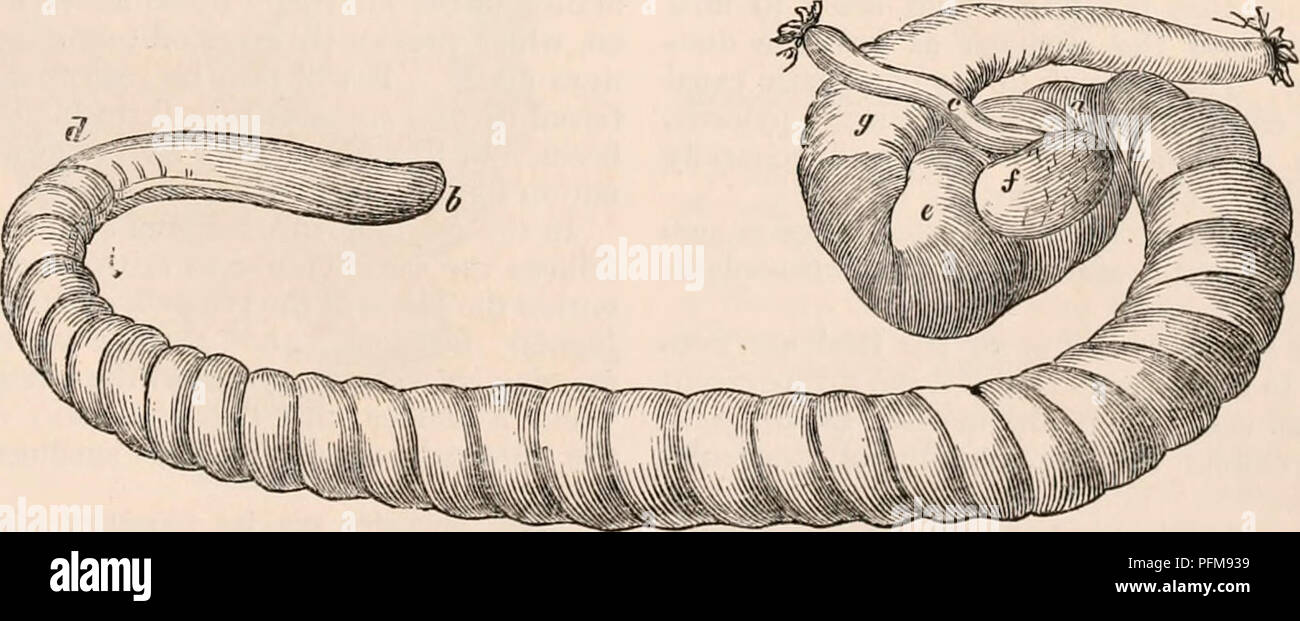. The cyclopædia of anatomy and physiology. Anatomy; Physiology; Zoology. Cacum of the Water Vole (Aricola amplii/m/s). I, m, end of the small intestine ; n, o,p, q, cagcum ; r, dilated commencement of the colon; s, point at which the colon becomes contracted. but slight traces of a spiral valve are visible at the commencement of the colon. In the water-rat (Arvicola amphibius) the small intestines are of equable diameter throughout their whole extent, but their calibre is small, as indeed is that of the large intestine. The caecum is, however, of enor- mous proportions (fig. 274. n, o, p, q),

Image details
Contributor:
Central Historic Books / Alamy Stock PhotoImage ID:
PFM939File size:
7.2 MB (320.8 KB Compressed download)Releases:
Model - no | Property - noDo I need a release?Dimensions:
2472 x 1011 px | 41.9 x 17.1 cm | 16.5 x 6.7 inches | 150dpiMore information:
This image is a public domain image, which means either that copyright has expired in the image or the copyright holder has waived their copyright. Alamy charges you a fee for access to the high resolution copy of the image.
This image could have imperfections as it’s either historical or reportage.
. The cyclopædia of anatomy and physiology. Anatomy; Physiology; Zoology. Cacum of the Water Vole (Aricola amplii/m/s). I, m, end of the small intestine ; n, o, p, q, cagcum ; r, dilated commencement of the colon; s, point at which the colon becomes contracted. but slight traces of a spiral valve are visible at the commencement of the colon. In the water-rat (Arvicola amphibius) the small intestines are of equable diameter throughout their whole extent, but their calibre is small, as indeed is that of the large intestine. The caecum is, however, of enor- mous proportions (fig. 274. n, o, p, q), and is divided at intervals into pouches by deep constrictions. The commencement of the colon (r) is extremely voluminous, but it soon diminishes in its diameter, and is twisted in a remarkable manner, so as to form several close spiral turns ; the walls of the small in- testine (/, m) are very thin and transparent; at the commencement of the colon its lining membrane is thrown into regular folds, which, as they appear through the transparent coats of the intestine, resemble a series of spiral muscular fibres. In other species belonging to the genus arvicola, the same disposition is observable. In the Cape moles (Bathiergus) the struc- ture of the caecum varies. In the orycterus of the Downs (Bathiereus marilimits) the caecum is short, and has its walls sacculated and puckered up, as it were, by tendinous bands. The colon begins by a wide pouch, and preserves through nearly its whole length a considerable diameter and sacculated ap- pearance, but on approaching the anus it be- comes contracted and of equable diameter. In the white-spotted orycterus (Bathiergus capensis) the caecum is much longer in pro- portion and of more equal calibre, although still very wide, in proportion to the size of the small intestine, and much sacculated; the com- mencement of the colon is at first of the same diameter as the caecum, but it soon be- comes narrower and spirally convoluted, much in t